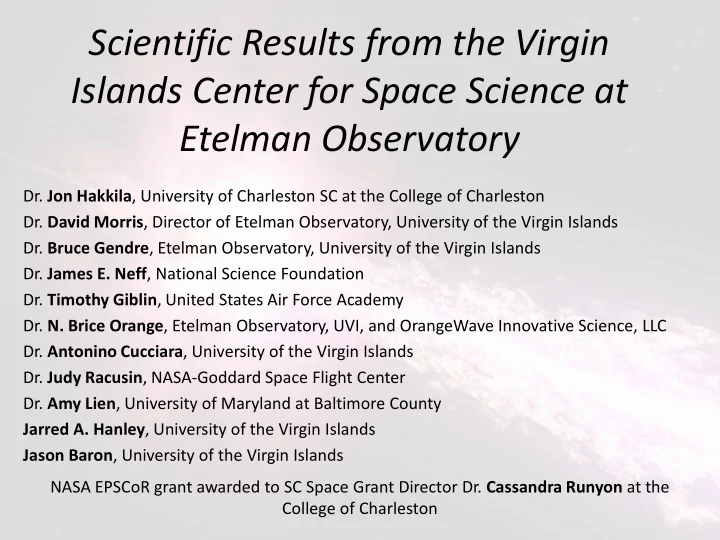

Scientific Results from the Virgin Islands Center for Space Science at Etelman Observatory Dr. Jon Hakkila , University of Charleston SC at the College of Charleston Dr. David Morris , Director of Etelman Observatory, University of the Virgin Islands Dr. Bruce Gendre , Etelman Observatory, University of the Virgin Islands Dr. James E. Neff , National Science Foundation Dr. Timothy Giblin , United States Air Force Academy Dr. N. Brice Orange , Etelman Observatory, UVI, and OrangeWave Innovative Science, LLC Dr. Antonino Cucciara , University of the Virgin Islands Dr. Judy Racusin , NASA-Goddard Space Flight Center Dr. Amy Lien , University of Maryland at Baltimore County Jarred A. Hanley , University of the Virgin Islands Jason Baron , University of the Virgin Islands NASA EPSCoR grant awarded to SC Space Grant Director Dr. Cassandra Runyon at the College of Charleston
Etelman Observatory, USVI • Location: Saint Thomas, United States Virgin Islands • Coordinates: Lat 18° 21′08.36″N, Long 64 ° 57′24.43″W • Altitude: 1325 ft.
UVI Telescope • 0.5 m automated f/10 Cassegrain telescope • Still in commissioning phase • Used for research, classes, and public outreach • Research – fast slewing is perfect for locating gamma-ray burst afterglows, unique longitude location is ideal for international observing campaigns
EPSCoR grant has dramatically improved Etelman operations • Upgrades to power, encoders, filter wheel, software, etc. • Building repairs and maintenance (e.g. roofs and gutters) • New computer infrastructure • Weather equipment • Climatized dome • Upgraded automated rapid response
Education and Outreach at Etelman • 11 summer undergraduate research students • 2 summer undergraduate research students sent to NASA/Goddard • 2 PhD student visits to UVI • New astronomy lab course introduced and taught at the observatory • UVI-NASA-EPSCoR curriculum development grant to expand UVI physics offerings • 20 very successful public evenings at Etelman
Science – Gamma-Ray Bursts • This EPSCoR Grant has contributed greatly to our understanding of GRBs (gamma-ray bursts) • GRBs are the most energetic explosions in the universe, lasting from tens of milliseconds to thousands of seconds and generating energies of around 10 51 ergs, mostly in the form of gamma-rays and x-rays. • GRBs originate at cosmological distances (redshifts 1-5) and appear to indicate beamed material with average Lorentz factors around 300.
General Prompt GRB Properties Light Curves Spectra α β E pk 25- 50 keV , 50 - 100 keV , 100 - 300 keV , 300 keV -1 MeV Most luminous sources in the Universe.
GRB Classes Short Long Hypernova Central Engine Model of Long GRBs Intermediate? The Intermediate class - statistically identified in BATSE and Swift data, although not unambiguously associated with a separate source population. Merging Compact Objects Central Engine Model of Short GRBs
GRB Afterglows GRB afterglow physics fairly well understood, indicating the deposition of energy into an external medium from relativistic shocks
Although thousands of GRBs have been observed by dozens of different satellites, we still do not understand • the radiation mechanism by which they produce their prompt emission • the physical structure and kinematics of the region producing the prompt emission, • the exact form of their (invisible) progenitors
GRB170202A Feb. 3, 2017 from Etelman Observatory: R = 20.8 +/ - 0.3, Resulting image from stacking 11 images
GRB Pulses 300 keV to 1 MeV 100 keV To 300 keV 50 keV To 100 keV 20 keV To 50 keV
GRB Pulse Residuals and Pulse Structure
GRB Pulse Profiles Composite Swift GRB pulse profile Composite BATSE GRB pulse profile
GRB Pulse Profiles Composite Short BATSE GRB pulse profile Composite Long BATSE GRB pulse profile
GRB X-ray Flare Profiles Composite x-ray flare pulse profile Composite Long BATSE GRB pulse profile
GRB optical flares Composite optical flare pulse profile Composite Long BATSE GRB pulse profile TBD usingEtelman Observatory
Large-scale universal structure Large scale structure found from Large scale structure found from Planck data (500,000 years after the Big Bang). 2MASS (out to 180 million years ago).
GRBs as Probes of Large-Scale Structure Hercules Corona Borealis Great Wall Giant GRB Ring Structure Size Distance Sloan Great Wall 1.4 billion ly 1 billion ly Clowes-Campusano LQG 2 billion ly x 1 billion ly 9.5 billion ly U1.11 LQG 2.2 billion ly 8.8 billion ly Huge-LQG 4 billion ly x 2 billion ly 9 billion ly Hercules-Corona Borealis 10 billion ly x 10 billion ly 10 billion ly Great Wall
Conclusions • With the help of EPSCoR, UVI’s Etelman Observatory has become a powerful tool for observing many astronomical objects, including GRB afterglows • The basic units of GRB emission are triple- peaked, hard-to-soft evolving pulses • All GRB classes have pulses exhibiting these non- monotonic behaviors, regardless of the nature of their progenitors • X-ray flares found in GRB afterglows exhibit behaviors similar to those of GRB pulses • The unknown physics of GRB pulses must be relatively simple and ubiquitous • GRBs are luminous and can be used to study large- scale universal structure
Recommend
More recommend